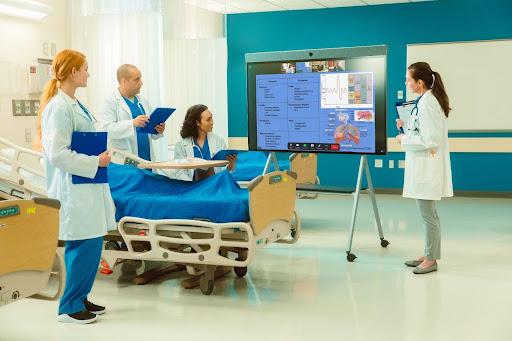
Re-imagining healthcare with Zoom’s AI-first platform
Zoom for Healthcare enables healthcare organizations to deliver seamless experiences across the patient journey and enhance collaboration among providers.
Updated on February 07, 2023
Published on May 27, 2021


For healthcare organizations, deciding which platform (or combination of platforms) to use for telehealth, patient communications, staff communications, care collaboration, and the many other facets of care delivery can be a challenge. You need to be able to trust that your platform of choice is secure, works well with other solutions in your technology ecosystem, and provides a high-quality patient experience at every touchpoint — whether it’s a phone call or virtual visit.
At Zoom, we often get questions about our healthcare platform and how well it meets the shifting demands of providers, health systems, and hospitals large and small. We’re here to answer the top 10 most frequently asked questions about Zoom for healthcare.
Zoom for Healthcare, which includes Zoom Meetings, Zoom Phone, and Zoom Team Chat, helps customers enable compliance with the Health Insurance Portability and Accountability Act (HIPAA) by employing administrative, technical, and physical safeguards to protect Protected Health Information (PHI) and by executing a business associate agreement (BAA). Zoom can also help Zoom for Government customers who are acting as a covered entity by executing a BAA to help them enable HIPAA-compliant programs.
However, HIPAA compliance is a shared responsibility. If you are a Covered Entity, as defined by the U.S. Department of Health and Human Services (HHS), acting as a healthcare provider, health plan, or healthcare clearinghouse, you are bound by privacy standards relating to any potential PHI that may be introduced to the Zoom environment.
Learn more about what features are available through Zoom for Healthcare and how we help customers enable HIPAA-compliant programs.
Yes, Zoom helps customers enable compliant programs with respect to data privacy laws like GDPR, Canadian federal privacy laws, such as the Personal Information Protection and Electronic Documents Act (PIPEDA) and, locally, the Personal Health Information Protection Act (PHIPA) with an executed Data Protection Agreement. Check out our PIPEDA/PHIPA compliance guide for more info.
Zoom Basic, our free plan, does not include an option to execute a BAA. You will need a Zoom account with at least one paid license (Pro or above), starting at $15.99 per month, to enter into a BAA. (Your patients may have a free Zoom Basic account for you to schedule meetings with them.) A paid Pro account will also give you access to features like live transcription, cloud recording, and the ability to assign a meeting scheduler, which is handy for allowing administrative staff to schedule appointments on behalf of providers.
The good news is, small clinics and practices in the U.S. requiring nine or fewer licenses can go online to accept a BAA for their account. Plus, Zoom’s centralized management makes it easy for smaller organizations without dedicated IT staff to manage their phone, chat, and video communications on one platform.
Zoom helps customers enable compliant programs by protecting PHI through administrative, technical, and physical safeguards. However, we highly recommend you follow our best practices to secure your Zoom meeting and prevent uninvited guests from joining.
Here are a few ways to enhance meeting security:
Many of these settings (with the exception of the last two) can be enabled at the account level so they’re required for all meetings scheduled by your staff and providers.
Zoom integrates with health information technology systems, electronic medical records (EMRs), and practice management platforms, like Epic, Nimbo, IntakeQ, NextPatient, Phreesia, ClinicOffice, and more. Depending on the integration, you can easily generate Zoom meeting links for each appointment with one click, automate appointment reminders to decrease cancellations and no-shows, collect payment for office visits, and leverage many other capabilities. We also integrate with platforms like Google Workspace and Microsoft Teams, and dozens of apps to help with scheduling, recording, and archiving.
Visit the Zoom App Marketplace to find apps that streamline and simplify your administrative tasks and care delivery.
Yes. With an executed BAA, you can use Zoom Phone’s products and features, including SMS, to communicate with patients. Used properly, Zoom Phone can help you securely send text messages, make and receive calls, or use features like visual voicemail and call recording. You can even use scheduling integrations like GReminders to send automated text message reminders to patients.
Yes, Zoom integrates with many types of medical devices for remote patient examination and monitoring, like electronic stethoscopes, otoscopes, general exam cameras, dermoscopes, and others. This allows providers to examine patients in virtual clinic settings without the need for face-to-face interaction.
Because Zoom has the ability to operate in low-bandwidth environments — common in rural and remote communities — integration with medical devices and telemedicine carts enables providers to conduct high-quality virtual exams remotely and improve access to care.
Yes. Zoom Phone supports interoperability with standards-based endpoints compliant with the latest security standards so you can easily use your existing hardware while switching to a cloud-based phone solution. You can also “Bring Your Own Carrier” with the option to use your current phone service provider, keeping your existing contracts, phone numbers, and calling rates while enjoying all the benefits and features of Zoom Phone. This blended model allows organizations to scale on demand and take advantage of Zoom’s single platform for voice, video, and chat communications.
Yes — Zoom’s platform allows you to create recordings. This means you can record patient encounters over Zoom to the cloud and add the recording link to a patient’s chart, or download the recording to store on your server. You can also download audio transcripts of Zoom meetings and add them to patient charts. Further, with Zoom Phone, you can download call recordings and voicemails and add those to your EMR to further document patient interactions.
Yes, our live transcription feature is available for Zoom healthcare accounts — all you need to do is enable live transcription in your settings before your meeting. When you are hosting a meeting, click Live Transcript to enable this service for participants. Providers and patients who are deaf or hard of hearing will be notified in the meeting that live transcription is available. Don’t forget that you can download the audio transcript when the meeting is over, edit the VTT file for accuracy, and even save the transcript to patients’ EMRs.
Want to learn more about our healthcare platform? Visit our Zoom for Healthcare page or our blog for the latest news.